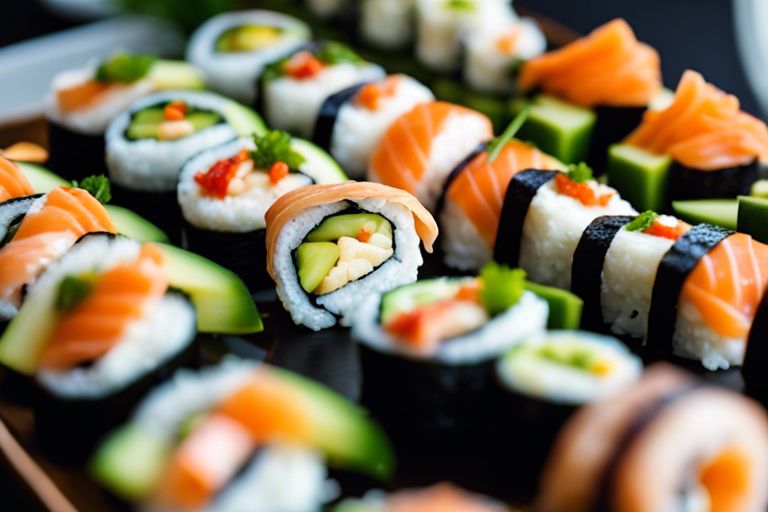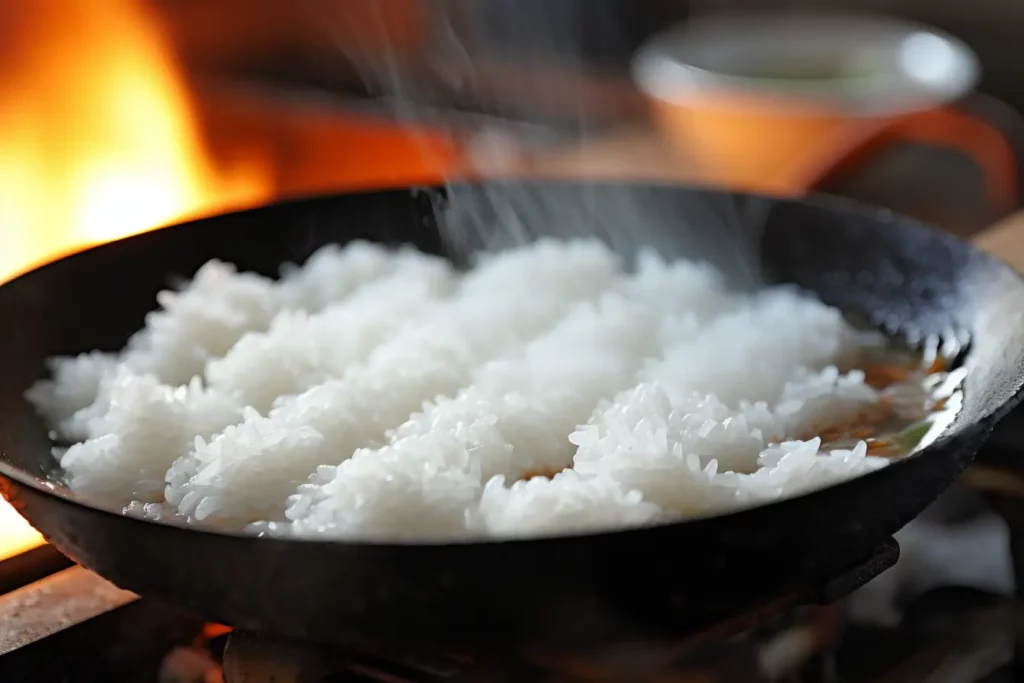Introduction
In this blog post, we’re going to look at the topic of “Mayonnaise and Creamy Sauces in Western-Inspired Sushi.” Sushi is now a popular dish around the world and has undergone many creative variations in Western countries. One of these variations is the use of mayonnaise and creamy sauces, which add a whole new flavor to traditional sushi.
The fusion of East and West
In recent years, the fusion of East Asian and Western cuisine has become more and more important. This is also evident in the use of mayonnaise and creamy sauces in sushi restaurants around the world. The combination of traditional ingredients with Western flavors has meant that sushi has become accessible to a wider audience.
This fusion of East and West has led to the continuous evolution of sushi cuisine, offering new creative opportunities to combine traditional Japanese cuisine with global influences. Mayonnaise and creamy sauces are an important part of this development and have helped make sushi a versatile and interesting dining experience.
The role of mayonnaise and creamy sauces in modern sushi
The use of mayonnaise and creamy sauces in modern sushi has greatly expanded the variety of flavors. They give the sushi rolls a creamy consistency and perfectly complement the fresh fish and crunchy vegetables. These sauces can also be used as a dip for sashimi or as a refinement for nigiri, thus offering an unlimited variety of possibilities.
The innovative use of mayonnaise and creamy sauces has meant that sushi is no longer seen as just a traditional Japanese dish, but rather as a culinary art form that is constantly evolving. This development has meant that sushi lovers around the world can enjoy the variety and creativity in modern sushi creations.
Keywords: mayonnaise, creamy sauces, sushi, fusion, east and west, modern cuisine
History of mayonnaise in sushi
Origins in Japan
The use of mayonnaise in sushi has gained popularity in Japan in recent years. The combination of creamy mayonnaise and the fresh flavors of sushi has conquered the palates of many Japanese. Especially among the younger generation, this Western-inspired ingredient has proven to be popular.
The origins of mayonnaise in sushi can be traced back to the efforts of Japanese sushi masters to explore new and innovative flavors. The integration of mayonnaise into traditional sushi dishes created a fusion of East and West, which can be found in many sushi restaurants today.
Global Distribution and Popularity
The global spread of mayonnaise in sushi has spread from Japanese restaurants to the whole world. In countries such as the United States, Canada, and Brazil, the use of mayonnaise in sushi is widespread and appreciated by sushi lovers.
The popularity of mayonnaise in sushi has led many sushi chefs to come up with creative and delicious variants with different flavors and textures. From Sriracha mayo to the classic Japanese Kewpie mayonnaise, the variety of mayonnaises in sushi has continued to evolve.
The use of mayonnaise in sushi has added a new dimension of flavor and expanded the variety of sushi cuisine. With a variety of flavors and uses, mayonnaise has made sushi a new culinary experience.
Recipes and variations
Classic mayonnaise-based sauces
For lovers of classic sauces, mayonnaise-based variations offer a delicious option. With ingredients such as lemon juice, mustard and spices, these sauces are easy to prepare and harmonize perfectly with traditional sushi.
A classic mayonnaise sauce is great for dipping California rolls or as a topping for salmon sashimi. The creamy texture and rich flavor make them an essential addition to any sushi menu.
Innovative creamy sauce creations
For those who crave new taste experiences, innovative creamy sauce creations offer an exciting alternative. By combining mayonnaise with exotic flavors such as wasabi, mango or ginger, exciting and unexpected taste explosions are created.
Try a creamy wasabi sauce with tuna maki rolls or a mango mayo sauce with shrimp tempura. These innovative creations are easy to customize and provide unplugged support for creativity in the sushi kitchen.
For more information on innovative creamy sauce creations and classic mayonnaise-based sauces, as well as delicious recipes and variations, read on in my blog post ‘Mayonnaise and Creamy Sauces in Western-Inspired Sushi’. You’ll also find tips on how to prepare it and recommendations for the best sushi pairings.
Tips and tricks for preparation
When it comes to making creamy sauces and mayonnaise for Western-inspired sushi, there are some important tips and tricks to keep in mind. A special highlight is the use of miso mayo, which adds a delicious umami note to your sushi dishes. Learn more about how to make miso mayo here.
Choosing the right ingredients
Choosing the right ingredients is crucial for making creamy sauces and mayonnaise for sushi. Use high-quality ingredients such as fresh eggs, rice vinegar, Japanese mustard, and of course, miso mayo to achieve the perfect flavor. Pay special attention to the quality of the miso, as this will have a significant impact on the taste of your sauces.
Techniques for perfect mixing
To achieve an even consistency and perfect mixing, it is important to use the right mixing techniques. A gentle, yet thorough blend is crucial to achieve the desired creaminess. Be sure to add the ingredients little by little and combine them with even movements to avoid lumps.
An important step in the mixing process is also stirring in the miso mayo to achieve a harmonious balance of flavors. This is crucial to ensure the perfect combination of sweet, salty, sour and umami and to add a unique flavor to your sushi.
Closing Words
Thank you for taking the time to read my blog post about mayonnaise and creamy sauces in western-inspired sushi. I hope you’ve gained interesting insights into the many ways these ingredients can influence sushi cuisine.
The Importance of Creativity in Sushi Culture
In sushi culture, creativity plays a crucial role. Sushi chefs are always on the lookout for new flavour combinations and forms of presentation to surprise and delight their guests. The creative evolution of sushi helps to keep this culinary tradition alive and dynamic.
Future Trends and the Evolution of Sushi Cuisine
Sushi cuisine is in a constant state of change. Future trends could include the use of locally inspired ingredients, the integration of modern preparation techniques, and the examination of health aspects. These developments will continue to make sushi cuisine exciting and attractive for lovers of culinary delights.
If you want to know more about the future plans and developments in sushi cuisine, subscribe to my blog and stay up to date!
FAQ
Q: What is the meaning of “mayonnaise and creamy sauces in Western-inspired sushi”?
A: “Mayonnaise and Creamy Sauces in Western-Inspired Sushi” is a modern variation of classic sushi that incorporates Western influences into the traditional preparation by adding creamy sauces, including mayonnaise.
Q: Are mayonnaise and creamy sauces traditional in sushi?
A: No, traditional sushi doesn’t usually use mayonnaise or creamy sauces. These ingredients are often added in modern, Western-inspired sushi creations.
Q: What flavors complement the mayonnaise and creamy sauces in Western-inspired sushi?
A: The mayonnaise and creamy sauces in Western-inspired sushi usually complement the flavor with their creaminess and can be sweet, spicy, or savory, depending on the variation.
Q: Are there vegetarian or vegan versions of mayonnaise and creamy sauces in Western-inspired sushi?
A: Yes, there are vegetarian and vegan versions of mayonnaise and creamy sauces that are based on plant-based ingredients and can therefore also be used in Western-inspired sushi.
Q: How to make mayonnaise and creamy sauces in Western-inspired sushi at home?
A: There are several recipes to make mayonnaise and creamy sauces for Western-inspired sushi at home. These can be adapted to individual taste by adding spices such as Sriracha, wasabi or lime.


